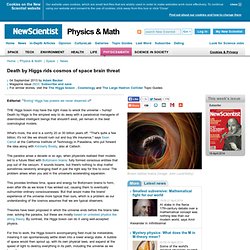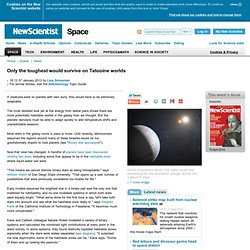

Search. Search for extraterrestrial intelligence. Bacterial explanation for Europa's rosy glow - 11 December 2001. The red tinge of Europa, one of Jupiter's moons, could be caused by frozen bits of bacteria.

Death by Higgs rids cosmos of space brain threat - physics-math - 04 September 2013. Editorial: "'Boring' Higgs has powers we never dreamed of" THE Higgs boson may have the right mass to wreck the universe – hurray!

Death by Higgs is the simplest way to do away with a paradoxical menagerie of disembodied intelligent beings that shouldn't exist, yet remain in the best cosmological models. What's more, the end is a comfy 20 or 30 billion years off. "That's quite a few billion; it's not like we should rush out and buy life insurance," says Sean Carroll at the California Institute of Technology in Pasadena, who put forward the idea along with Kimberly Boddy, also at Caltech.
The paradox arose a decade or so ago, when physicists realised their models led to a future filled with Boltzmann brains: fully formed conscious entities that pop out of the vacuum. Researchers claim that life arrived on Earth via asteroids and comets, but not in the way you think. Not so long ago, there was quite a bit of skepticism about the panspermia hypothesis — the idea that life on Earth got started by using alien molecules deposited by stellar travelers like comets or asteroids.

"Did Life First Appear on Alien Worlds 12-13 Billion Years Ago?" This means that planets that could potentially have supported life may have formed eight, ten, maybe even twelve billion years ago.

Surveys do detect a decrease in the number of planet-hosting stars with decreasing metallicity, but this drop is much shallower for terrestrial planets than it is for gas giants. Of course, the presence of some heavy elements during the planet-building phases is required, but the minimum level has not yet been determined. The raw materials for building terrestrial planets were available very soon after the Big Bang, raising the possibility that there could be life in the Universe far older than ours. Perhaps they reside around long-lived red dwarf stars, or have moved on from their home system after their star expired. Or, perhaps, we really are the first, which means that if life has happened just once throughout the entire history of the Universe, our existence must be a fluke and our planet very, very special indeed.
Journal reference: Nature. Only the toughest would survive on Tatooine worlds - space - 07 January 2013. If creatures exist on planets with twin suns, they would have to be extremely adaptable.

The most detailed look yet at the energy from stellar pairs shows there are more potentially habitable worlds in the galaxy than we thought. But the planets' denizens must be able to adapt quickly to wild temperature shifts and unpredictable seasons. Most stars in the galaxy come in pairs or more. Binary Stars May Give Alien Life a Boost. Planets with two parent stars face a double whammy of radiation, a situation that would seemingly make them far less suitable for life than single-star systems.

But appearances can be deceiving. GALLERY: Top Exoplanets for Alien Life. Pollution on other worlds may show advanced alien life - space - 27 June 2014. Life is messy.

So to find aliens, why not look for their pollution? As part of its mission, NASA's upcoming James Webb Space Telescope (JWST) will be able to look at starlight filtered through the atmospheres of Earth-sized planets and search for signs of life. Most proposed plans involve hunting for highly reactive gases such as oxygen that usually need a living source to replenish them. Vitamin B3 might have been made in space, delivered to Earth by meteorites. Ancient Earth might have had an extraterrestrial supply of vitamin B3 delivered by carbon-rich meteorites, according to a new analysis by NASA-funded researchers.

Dn23051-1_270. Strange life signs found on meteorites. WASHINGTON, D.C. - A NASA scientist reports detecting tiny fossilized bacteria on three meteorites, and maintains these microscopic life forms are not native to Earth.

If confirmed, this research would suggest life in the universe is widespread and life on Earth may have come from elsewhere in the solar system, riding to our planet on space rocks like comets, moons and other astral bodies. The study, published online late Friday in The Journal of Cosmology, is considered so controversial it is accompanied by a statement from the journal's editor seeking other scientific comment, which is to be published starting on Monday.
Alien Algae? Scientists Say They Have Found Microfossils in Meteorite. This image shows a large and very complex, thick-walled, carbon-rich microfossil that the team has identified as a hystrichosphere.

Scale bar – 100 μm (Jamie Wallis et al) “A bright yellow fireball that turned green as it travelled across the sky was observed by several eyewitnesses in the North Central Province of Polonnaruwa, Sri Lanka on December 29, 2012,” the team wrote in the paper. “Local police officials responded immediately by collecting samples and submitting them to the Medical Research Institute of the Ministry of Health in Colombo, Sri Lanka.” Sri Lankan researchers obtained over 628 samples, of which only three were found to be possible meteorite fragments. “Preliminary optical microscopic studies of deep interior samples extracted from the stones revealed the presence of a wide range of 10-40 μm-sized objects with a morphology characteristic of siliceous microalgae known as diatoms.”
One of the original samples was then sent to Cardiff University for analysis. "Humans May be the First Generation of Advanced Life in the Milky Way" And conduct commerce with them,” Sasselov said. “We don’t now have the technology to physically travel outside our solar system for such an exchange to take place, but we are like Columbus centuries ago, learning fast how to get somewhere few think possible.” Sasselov believes that life is probably common in the universe. He said that he believes life is a natural “planetary phenomenon” that occurs easily on planets with the right conditions. “It takes a long time to do this,” Sasselov said at a 2011 Harvard conference.
Astrophile: Rhythmic dance helps star lovers mature - space - 19 July 2013. Astrophile is our weekly column on curious cosmic objects, from the solar system to the far reaches of the multiverse Objects: Harmonious binary starsTemperaments: Mature beyond their years When two young stars get together, it is never clear how their relationship will play out. Should the pair fail to get along, anyone caught in their path is at risk from violent fallout. Top Exoplanets for Alien Life: Photos. The Wow! Signal: Intercepted Alien Transmission? SETI, the search for extraterrestrial intelligence, has seen astronomers scouring the sky for decades in hopes of receiving artificially generated radio signals sent by alien civilizations.
But then, there’s a good chance we’ve already found just such a signal. And 1977 saw the most tantalizing glimpse ever. Nicknamed the “Wow!” Signal, this was a brief burst of radio waves detected by astronomer Jerry Ehman who was working on a SETI project at the Big Ear radio telescope, Ohio. The signal was, in fact, so remarkable that Ehman circled it on the computer printout, writing “Wow!” The frugal alien's beacon. The frugal alien's beacon KEITH COOPERASTRONOMY NOWPosted: 8 June 2010 August, 15 1977: a pulse of radio waves at 1,420MHz radiates down from space to be received by the Big Ear radio telescope in Ohio for 72 seconds. Then: nothing. Sporadic searches of the area since have failed to find this interstellar radio chorus. Big Ear Radio Observatory - Explanation of 6EQUJ5. An Anomalous SETI Signal on February 6th May Be From an Extraterrestrial Intelligence « Ovni News.
Search for alien life about to step up a gear. The step change comes as the most powerful telescopes ever built are about to enter into service and as ideas about where life could exist are being turned on their head.